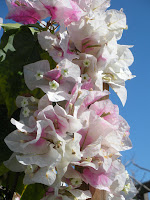
Volunteers Tony Donzello and Win Turner have been busy readying the new orchid house for our expanding collection. With its new irrigation system, including a water filtration system with a 5-zone capability, this new house will help volunteer Sandy Catron meet the growing requirements for the many species on site. With over 550 square feet of bench space, and much more hanging space, this former swale is becoming a haven for our exotic beauties. .
Vandas have become increasingly popular because they are vigorous, produce a profusion of flowers and are easy to grow in southern Florida. Most grow happily when hung from a tree or a structure; others can be planted in the ground and trained to climb a tree or pole. While many orchid species flower in cooler months, vandas reward their caregiver with blooms 2, 3 or more times per year and the flowers last up to 6 weeks. A well-grown plant will show its appreciation with continuous growth and blooms. Vandas react best to light shade, airy, natural environments with nighttime temperatures ranging from 60-75°F and daytime temperatures of 80-90°F. Temperatures cooler than 50°F will send Vandas into dormancy. Treat them with heavy misting during prolonged periods of temperatures over 90°F.
 Sandy feeds every orchid by hand, including this giant Vanda insignis in the old orchid house.
Sandy feeds every orchid by hand, including this giant Vanda insignis in the old orchid house. Vandas respond well to repeated watering until saturated. This is best done in the morning giving foliage a chance to dry out before nightfall. You’ll know that you have an adequately watered plant when the roots are a deep green. If roots are white or partially white, continue to water. In hot weather you may need to water everyday, otherwise water when soil is dry on the surface. Drought stress shows as pale green or yellow leaf color. Sandy recommends a weekly application of 15-5-15 fertilizer, mixed at a rate of 1.5-2 Tbs. per gallon of water, during the summer, reduce to once or twice a month in cooler weather.
Vandas don’t like to be disturbed. If divided, offshoots should have three roots on them and be properly secured to a large container.
Send us your feedback!!
Interested in a particular plant?
Want to hear about other botanical gardens?
Perhaps you are wondering what the staff here at the Garden is reading these days.
Whatever your interest, let me know what you would like to hear about in our blogs. I’ll do my best to answer your questions, and bring you the information that you are looking for! Send your request to info@naplesgarden.org.
Docents Needed!!
Do you like to socialize?
Are you hungry to learn and share knowledge?
Do you enjoy dealing with the public?
If you answered, “Yes!” to these questions, call us about being a docent at the Garden! Or if this sounds more like your friend, ask them to call!!
Contact David Webb @ 239.643.7275 or email him at dwebb@naplesgarden.org.















